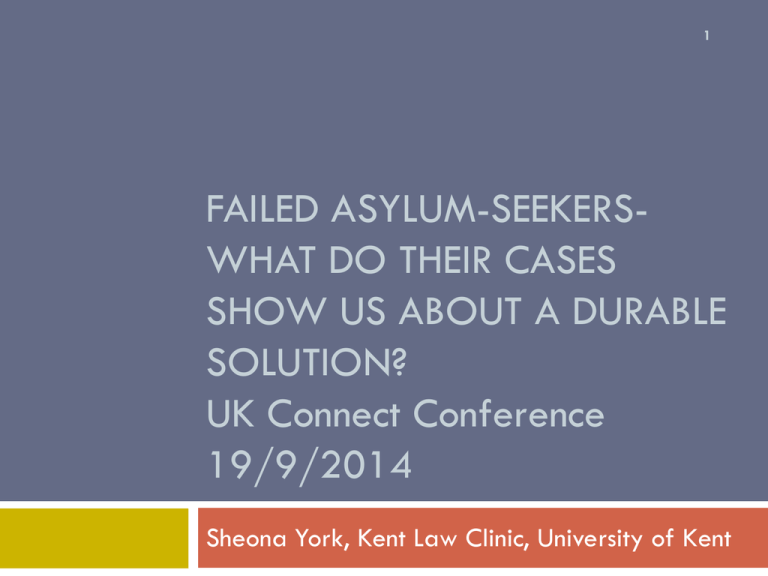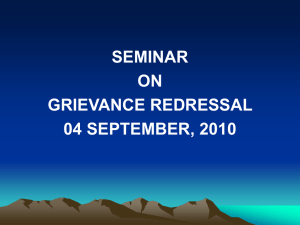Failed asylum-seekers - Garden Court Chambers
advertisement

1 FAILED ASYLUM-SEEKERSWHAT DO THEIR CASES SHOW US ABOUT A DURABLE SOLUTION? UK Connect Conference 19/9/2014 Sheona York, Kent Law Clinic, University of Kent Kent Law Clinic’s research: ‘How children become failed asylum-seekers’ 2 In 2012, the Court of Appeal in KA (Afghanistan) suggested that young asylum-seekers for whom the Home Office did not endeavour to trace their families, in breach of the EU Reception Directive, may therefore have lacked corroboration of their asylum claim, and may merit ‘a remedy’. Kent Law Clinic looked for young Afghan ‘failed asylum-seekers’, of which around 100 were though to be living in Kent, offering to make a fresh claim if possible, while researching what had gone wrong in their cases. Basic requirements or elements of how to arrive at a durable solution for a child: some suggestions 3 Any migrant child or young person must be given enough time and the right conditions to enable them to explain their circumstances as fully as they can. Such explanation not to be a once-and-for-all asylum interview, which is then forensically and nitpickingly examined for tiny differences with other information given by or on behalf of the child Even for young people who may not have an asylum claim... 4 As a minimum, any initial decision-making process must consider adopting a shared burden of proof, or, at least, putting into practice the UN Handbook, which requires a shared burden of establishing the facts (UN Handbook para 196) ‘...Thus, while the burden of proof in principle rests on the applicant, the duty to ascertain and evaluate all the relevant facts is shared between the applicant and the examiner. Indeed, in some cases, it may be for the examiner to use all the means at his disposal to produce the necessary evidence in support of the application...’ More basic requirements... 5 Whatever it takes to confront the ‘culture of disbelief’, particularly in the Home Office, but also in the tribunal, must be done. Nothing will be achieved without doing this; - but see what Damien Green said to Kent County Council, begging for proper funding for councils to assist all young people covered by the leaving care provisions: House of Commons Education Committee HC 149-1: evidence: q 138 6 Damian Green: I do not have the costs in front of me, but you make the point that this has to be money that comes from somewhere. Again, I return to the point that that would send quite a powerful signal around the world: get to Britain before you are 18, and you can then live off the British taxpayer until you are 24. I do not think that would be a helpful signal, either for the individuals themselves or certainly for the British taxpayer. Our research showed how a messed –up asylum claim is not a durable solution. 7 Some of the problems we found: Unlawful interviews, including unlawful detention, on and shortly after arrival; Age assessments as older than claimed age: no Merton-compliant assessment provided until later or at all Poor legal advice, especially failure to appeal a first refusal of asylum Further application for leave to remain at 17 ½ not supported by any or any fresh evidence Further problems found in our cases: 8 Refusals relying on ‘evidence’ unlawfully obtained and ‘discrepancies’ (for example from an age assessment) not shown to or put to the young person The issue of family tracing was often used to discredit the young person’s claim. Home Office and Tribunal consideration laced with the ‘culture of disbelief’ In particular, the Tribunals and eventually even the Court of Appeal showing clear circular reasoning in relation to family tracing Some quick examples: no proper evidence record 9 Case 5 was recorded as having in his jacket pocket a notebook containing telephone numbers. The notebook was not kept as evidence. No official attempted to telephone any of the numbers, nor was the applicant properly asked where the notebook came from. This notebook was relied on that he had been untruthful about his family. He explained to Kent Law Clinic that he had been smuggled to the UK in a refrigerated lorry, and given five jackets, to keep him warm. We were the first people in several years, to have interviewed him properly. Age assessments: 10 16 of our 20 case examples had been age disputed, some by only a few months, others by 1-3 years. Always older than their claimed age. The Home Office often relied on 1-page summaries from Social Services. A full report was not always available, even by the time of an appeal. The Tribunal dealt inconsistently with this issue: Case W- accepted his claimed age in default of any written report Case A: 1-page report accepted as ‘the most reliable evidence’ Case C: case remitted because no Merton-compliant assessment- then waited over a year for a new decision. Reasons for Refusal letters (RFRLs) 11 The UNHCR Guidelines on children’s asylum claims were rarely followed. Almost always the main reasons for refusal were ‘lack of credibility’; ‘implausibility’; ‘failure to adduce evidence’. ‘your claim is based on information given to you by your mother, and therefore considered to be subjective. You have adduced no evidence...’ ‘you have adduced no evidence’ to support your view that your father was taken by the Taliban...’ Legal issues in RFRLs: 12 Reliance on unlawful interviews and on age assessments to dispute credibility without putting the discrepancies to the young person Lack of consideration of child-specific persecution (such as being an orphan and therefore a member of a ‘particular social group’ in Afghanistan) More recent RFRLs, especially from the Kent local immigration team, were immensely long, quoting long passages from cases not relevant to the young person. Hard not to believe this is not just intimidation directed at inexperienced legal representatives. More legal issues in RFRLs: the best interests of the child... 13 Failure to consider the best interests of the child in discussing relocation (‘it is considered safe for you to return to Kabul...’) Treating the best interests of the child as a duty which gradually fades away as the young person approaches 18: ‘You will soon turn 18 and then ..... You will no longer meet the definition of a child...’ (that young person had been found to be an orphan and at risk in his home area, but...) Problems with legal representation 14 Of 12 cases with an initial right of appeal, 10 did not appeal. Very few were explicitly advised that they had lost their case, simply that they had been granted ‘a visa’ and they could apply again later. Most of these simply sent an HPDL form, with no further evidence, and no attempt to deal with the issues raised in the refusal letter. All of those applications were refused: all appealed, and all lost. The baleful effect of legal aid contracting... 15 At the first appeal stage, many were ‘merits failed’ by their legal representative. Several representatives failed to identify clear Convention grounds or valid legal arguments, and none applied the more generous criteria for granting legal aid to children (at that stage children with ‘borderline’ cases should have been granted legal aid). One firm ‘merits failed’ the client but offered to do the appeal privately for £1500. Another legal aid firm took on the case, appealed out of time and the child got refugee status. Recommendations for legal representatives: 16 Not just training or accreditation, but a requirement that legal representatives represent their clients, rather than acting as quasi- judges: ‘... Your performance at your asylum interview was poor, ...and I opine that your account is vague and lacking in detail... I advise you that an appeal would have insufficient merit...’ The legal aid contracting system must eradicate perverse incentives not to appeal children’s refusals of asylum, for example the burdensome need to apply for an extension beyond £800/ approx 12 hours work on a case. The family tracing issue: ‘reversing the duty’ 17 In none of our cases was any family tracing carried out. Some RFRLs said it was not possible, and others advised the applicant to contact the Red Cross. Others said: ‘...you have attempted to contact your family through the Red Cross. It is considered that you are trying to contact your family and therefore you can be reunited with them on your return...’ ‘it is considered that you have failed to provide enough information about your family ... It is considered that you have failed to discharge the duty placed on you in KA’ (we found the client’s village easily on the internet) The asylum process itself does not best serve a child or young person: ex. 1 18 Case X arrived aged 15. Assessed as over 18, interviewed and detained for 12 months to be sent to Greece. No initial legal advice. Solicitors obtained injunction against removal (all removals to Greece stopped in 2011 – case of NS) Case X was finally interviewed 3 years after arrival, still treated as an adult On appeal, it was accepted that he had been a child on arrival, but found not to be at risk now, as an adult on his own claimed age. The judge relied on the screening interview, despite knowing that it had been carried out without proper safeguards The asylum process itself does not best serve a child or young person: ex. 2 19 Case Z arrived in 2007. Accepted as 15. Refused but granted 2 years’ DL. Not advised to appeal. Applied for an extension of DL 2 years later. After 7 months it was refused. His appeal was allowed on a technicality (s47 dual decision point). Referred back to HO for new decision. No hearing. After 9 months a further refusal but not received either by client or legal representative After 8 further months, Z hears that his case was refused. When Kent Law Clinic met him, he was paying a private solicitor but no idea what that solicitor was doing for him. He has never had his case considered before a tribunal. Circular reasoning in the Tribunal and Courts goes like this: 20 An appeal is dismissed on credibility grounds It is inferred from this that the appellant has not given true information about his family Which leads to an unchallengeable finding of fact about his family Tracing may have produced useful evidence for the child But because of the finding regarding his family it is decided that tracing would have been unsuccessful, so no loss can have arisen from the failure to trace. EU: the Court of Appeal’s view of Afghan families 21 Para 10: Lastly, I should mention a point made by the Secretary of State which I consider to have substance. Unaccompanied children who arrive in this country from Afghanistan have done so as a result of someone, presumably their families, paying for their fare and/or for a socalled agent to arrange their journey to this country. The costs incurred by the family will have been considerable, relative to the wealth of the average Afghan family. The motivation for their incurring that cost may be that their child faces risk if he or she remains with them in Afghanistan, or it may simply be that they believe that their child will have a better life in this country. Either way, they are unlikely to be happy to cooperate with an agent of the Secretary of State for the return of their child to Afghanistan, which would mean the waste of their investment in his or her journey here. EU: should the courts act as a sanction against the Secretary of State? 22 Para 6: I do not think that the Court should require or encourage the Secretary of State to grant leave in such circumstances either in order to mark the Court's displeasure at her conduct, or as a sanction for her misconduct. I do not think that the Court should require or encourage the Secretary of State to grant leave in such circumstances either in order to mark the Court's displeasure at her conduct, or as a sanction for her misconduct. Conclusion: 23 Given the above difficulties, even to achieve a just determination for a young person, whether or not leading to a durable solution for them, would be a big achievement. Some references (full list in the research report) 24 How children become failed asylum-seekers University of Kent June 2014 http://www.kent.ac.uk/law/clinic/how_children_becom e_failed_asylum-seekers.pdf KA (Afghanistan) [2012] EWCA Civ 1014 UN Handbook on Procedures and Criteria for Determining Refugee Status under the 1951 Convention R(AN & FN v SSHD) [2012] EWCA Civ 1636; VS v SSHD [2014] EWHC 2483 (QB) LQ (Afghanistan) [2008] UKIAT 00005 EU (Afghanistan) [2013] EWCA Civ 32







